These lovely DIY rose lotion bars from guest blogger Irena of Country Hill Cottage are made with natural, non-toxic ingredients and are perfect for moisturizing dry skin. They’re also formulated without beeswax for a lotion bar recipe that’s completely plant-based and ideal for vegans. Read on to learn more about the ingredients and get helpful tips for creating your own homemade rose lotion bars.
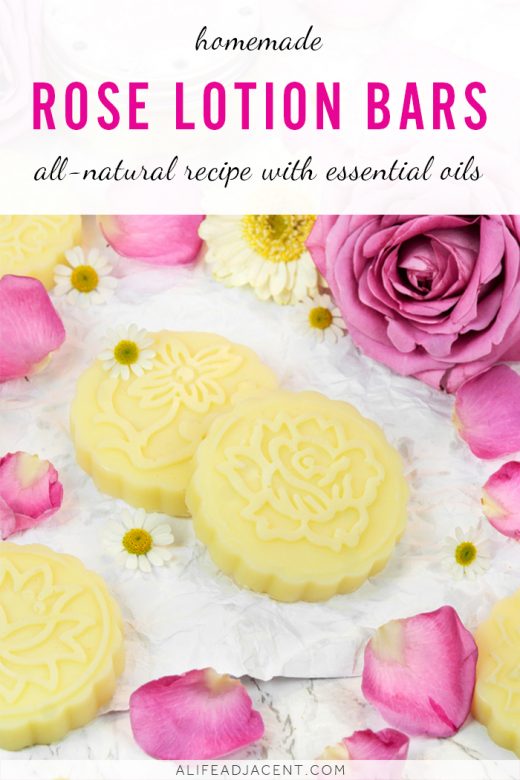
Moisturize your skin with softening and soothing DIY rose lotion bars! These all-natural vegan lotion bars are made with plant-based butters and oils that deeply nourish your skin with vitamins and antioxidants. This homemade rose-scented lotion bar recipe is suitable for all skin types, even sensitive skin, and can be used on the entire body.
The lotion bars are a wonderful way to hydrate dry skin and soften rough elbows, knees, and cracked feet. Enriched with vitamin E oil and fragrant rose essential oil, the bars are a great homemade skincare option and can be used as a body lotion or as a massage oil. Enjoy!
Irena xx

What ingredients do I need to make rose lotion bars?
As the name suggests, a lotion bar is body lotion in solid form. Since this recipe doesn’t contain any water, there is no need to add any preservatives. In fact, the bars are made with natural, plant-based materials. Before delving into the recipe, let’s have a look at the ingredients and their skincare benefits:
Nourishing butters
The main ingredients of the rose lotion bars are cocoa butter, shea butter, and mango butter. All three are excellent moisturizers that soften and soothe the skin. Cocoa butter also adds firmness to the bars, while shea butter and mango butter are rich in vitamins A, C, and E and hydrate the skin on a deeper level. When purchasing butters, make sure that they are organic and cold-processed or unrefined since refined products contain fewer vitamins and nutrients.
Babassu oil
Babassu oil is another excellent moisturizer that absorbs quickly into the skin. This oil doesn’t feel greasy and helps to balance sebum production and the natural oils of the skin. It’s full of antioxidants and has anti-inflammatory properties that can help to combat skin inflammation.

Candelilla wax
A small amount of candelilla wax helps to harden the bars. This vegan wax also binds and emulsifies the oils, improving the skin feel of the bars. Lanolin or beeswax are also great options if you don’t mind using an animal product in your beauty recipe.
Vitamin E oil
Vitamin E oil (alpha-tocopherol) is a natural nutrient and an antioxidant that can help to protect your skin from free radical damage. I also find that it revitalizes the skin, reduces blemishes and can improve the appearance of stretch marks and scars. When shopping for vitamin E oil, be sure to buy a plant-based oil instead of a synthetically created one as the former is said to be better absorbed by the skin.
Rose essential oil
I love the smell of roses and decided to fragrance the lotion bars with rose otto essential oil. Although rose essential oils can be quite pricey, I found one that smells lovely and is affordable. If you prefer another scent, try lavender, jasmine, geranium, or ylang-ylang essential oil. If you have very sensitive skin or plan to use the lotion bars on babies or small children, it’s best to prepare the recipe without any essential oils.
Silicone mold
I used a round moon cake mold to form my lotion bars. This mold produces bars that fit nicely into the palm of your hand and also creates a lovely decorative pattern. However, you can also pour the lotion mixture into a small cupcake pan or ice cube tray. I recommend using a mold that’s made of soft, bendable silicone so you can pop the lotion bars out easily.
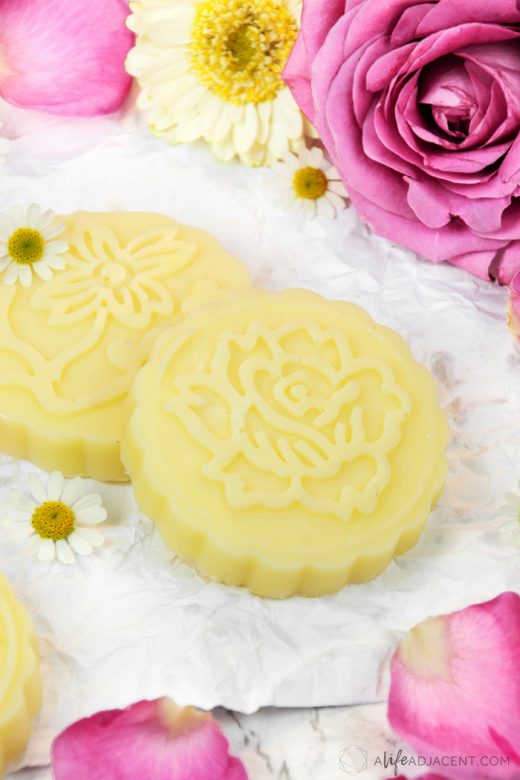
Low PUFA Ingredients for Lotion Bars
I love the moisturizing qualities of the oils and butters mentioned above and use them in many beauty recipes. Another reason why I highly recommend them in is their low content of PUFAs. Let me explain:
Fats can be divided into two groups: stable, saturated fatty acids (SFAs) and unstable, unsaturated fatty acids, which can be further categorized into monounsaturated (MUFAs) and polyunsaturated fatty acids (PUFAs). But what does that mean for skin care?
Polyunsaturated fats are highly reactive because they have two or more incomplete hydrogen bonds and are easily oxidized by heat and light. This oxidation process creates free radicals. Put in very simple terms, free radicals are highly reactive, uncharged molecules that can bind electrons from atoms in the skin. This process damages the skin cells and speeds up skin ageing.

Download these gorgeous printable labels for your lotion bars at the bottom of this post!
When selecting the ingredients for the rose lotion bars, I specifically chose cocoa, shea, and mango butter as well as babassu oil because they are made up mostly of saturated fats and are less prone to oxidation. I also briefly mentioned that the materials in these rose lotion bars are full of vitamins and antioxidants that help to neutralize free radicals by providing an extra electron. Using low-PUFA fats and ingredients that are rich in antioxidants is the best way to ensure that your homemade skin care products are safe and actually beneficial for your skin.
Kyla has written an in-depth article about the dangers of polyunsaturated fats in skincare, where you can learn more about the differences between saturated, monounsaturated and polyunsaturated oils and how to choose skincare products accordingly.
Tips for making DIY lotion bars
Making my DIY rose lotion bars for vegans is very simple, and with the following tips, you will have much success in making your own lotion bars at home.
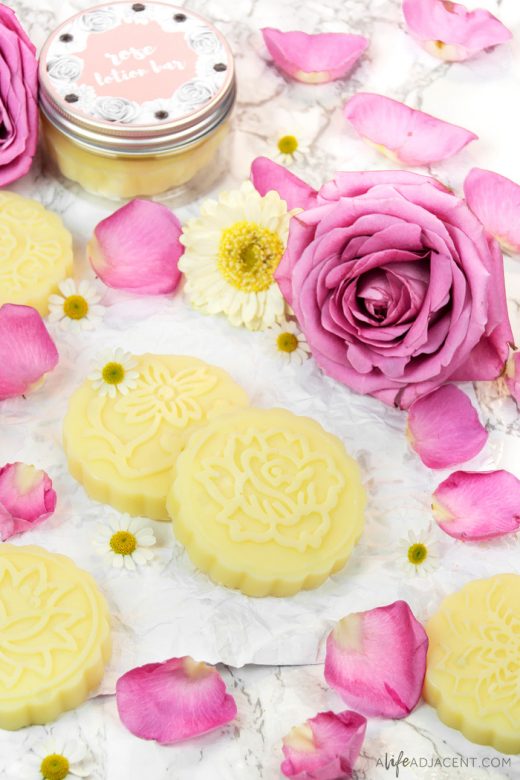
- Looking at the recipe you will notice that candelilla wax is melted separately from the oils and butters. Here is why: Candelilla wax melts between 150°F and 165°F (65°C – 75°C), while the butters have a lower melting point at around 85°F to 105°F (30°C – 40°C). Overheating the butters (heating past 105°F / 40°C) is going to alter their texture and can result in bars that feel grainy and oily – not at all what we want!
- An instant-read thermometer is useful to get exact temperatures. If you don’t have one, be extra careful to set up the water bath over the lowest flame and stir constantly.
- After the butters have melted, let the lotion mixture cool for 10 minutes before adding the vitamin E oil and essential oil. Both oils could evaporate if the mixture is still too hot.
- Cocoa butter takes quite a long time to regain its original hardness. Therefore I recommend chilling the lotion bars in the refrigerator for at least 6 hours or overnight before releasing them from the mold.
DIY Rose Lotion Bars
What You'll Need
Ingredients
- 1 oz (30g) candelilla wax
- 7 oz (200g) cocoa butter
- 5.6 oz (160g) shea butter
- 1.4 oz (40g) mango butter
- 1.4 oz (40g) babassu oil
- 20 drops (0.04 oz / 1 g) vitamin E oil
- up to 50 drops (0.08 oz / 2.5 g) rose otto essential oil
Supplies
Instructions
- Melt the candelilla wax. Put the wax into a microwave-safe container and melt in the microwave set to medium in 30-second bursts until fully melted.
- Place the cocoa butter, shea butter, mango butter and babassu oil into a heat-resistant mixing bowl and melt in a water bath over low flame. Then take off the heat and combine with the melted candelilla wax. Set aside to cool for 10 minutes.
- Once the mixture has cooled, stir in the rose essential oil and vitamin E oil.
- Pour the lotion mixture into the mould and put in the fridge to set overnight. Note that it takes several hours for cocoa butter to completely set. Tip: Put the mould on a tray or cutting board so you can handle and lift mould more easily.
- Gently bend the mould to pop the lotion bars out.
How to use the DIY rose lotion bars
Rub and massage the lotion bar on your skin. The warmth of your hand and body will soften the bar, releasing the moisturizing butters and oils. For the best effect, apply the lotion bar immediately after taking a bath or shower. Wait a few moments before covering the treated area with clothes so your skin can absorb the oils. I also love using rose lotion bars on my hands before doing the dishes to protect my skin from drying out.
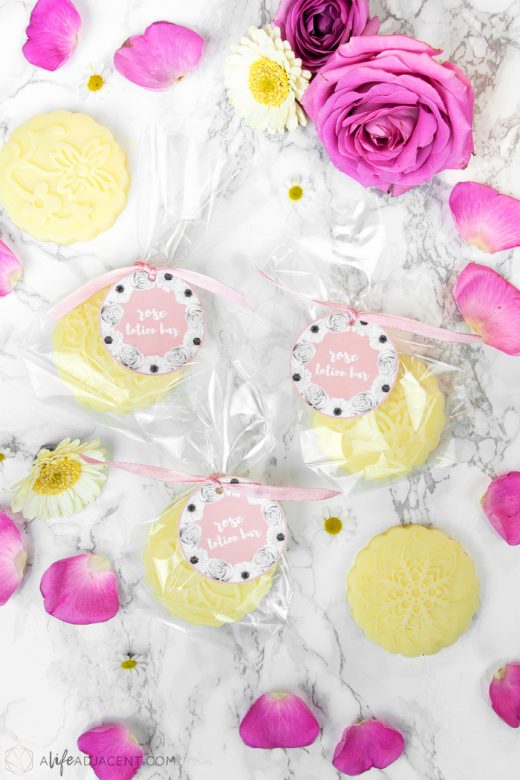
Shelf life and storage
Store the homemade rose lotion bars in an airtight container, away from moisture, heat, and sunlight. The bars melt at around 75°F (25°C), so make sure to keep them in a cool place, too. In the summer months, I usually put them in my fridge and enjoy the additional cooling effect. The lotion bars have a shelf life of up to one year.
Printable labels
The ladies also created gorgeous printable labels for this rose lotion bar recipe. You can place one on your bar storage jar, or add a tag and a bow for easy gifting! Download printable.
If you enjoyed this rose vegan lotion bar recipe, you might also like:
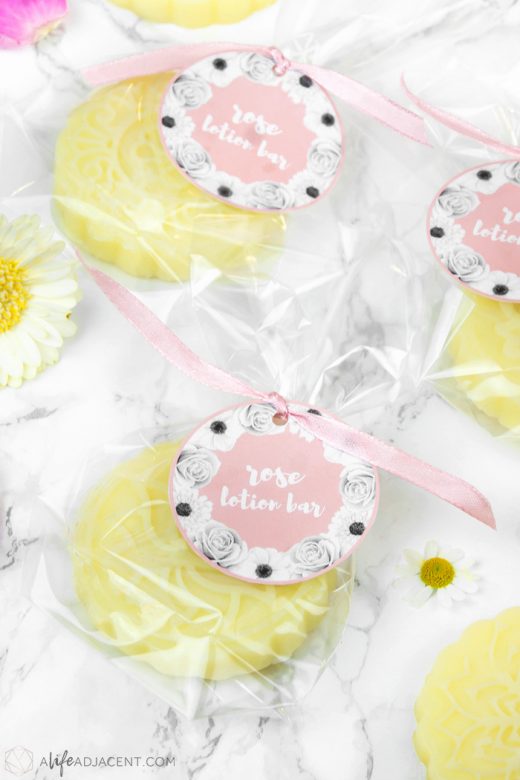
Pin it for later
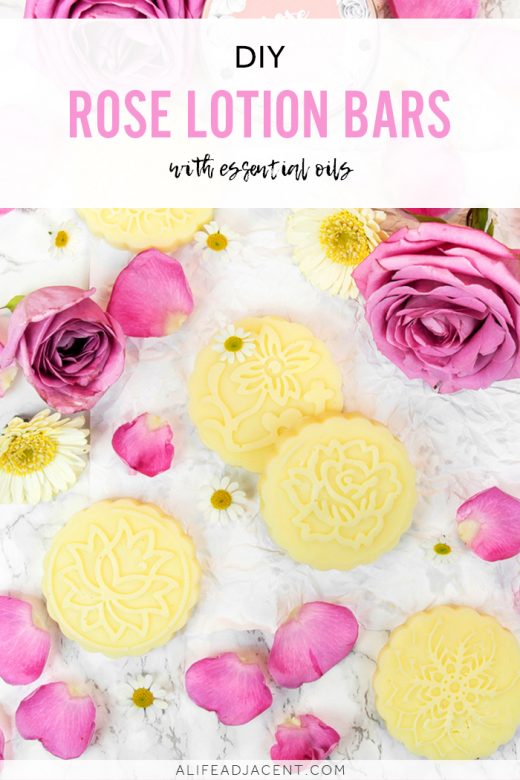

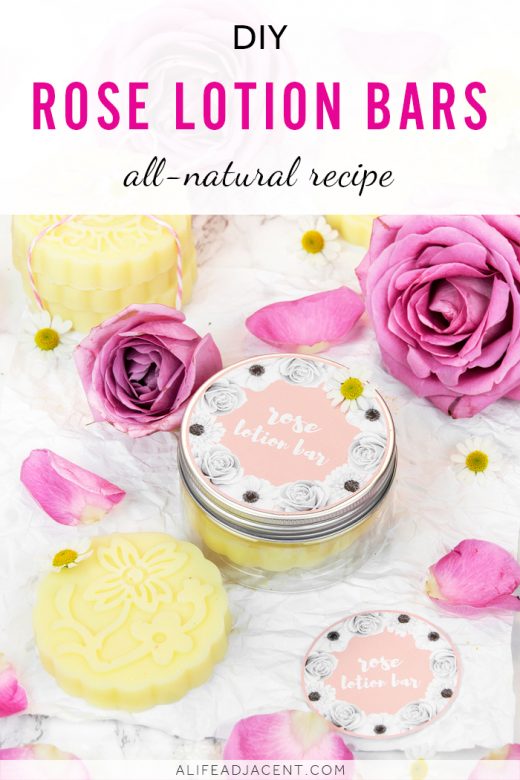

Bev.
Friday 26th of August 2022
I've been looking for a really good recipe for lotion bars. The recipes I tried came out greasy . I haven't tried your recipe yet, but I wanted to know if I could put arrowroot powder in it ,if so how much ? I would also like a little color, could I uses Rose Kaolin Clay or if you have another suggestion for something that is all natural and again how much would I need ? I'm really new at this. Thank You So Much , Bev.
Kim
Tuesday 20th of September 2022
Hi Bev, we're very sorry for the delay in responding to your question. We wanted to do a tester batch before getting back to you so we could tell you exactly how much arrowroot to add, but we've been so busy with our recent recipes that we still haven't found the time. However, we have used arrowroot powder in body butter and body scrub recipes before to give them a less greasy texture. So we think adding a small amount should work. Without testing it ourselves however, we can’t say for sure but you could start with 2 teaspoons.
Also, you can absolutely also add rose clay to color lotion bars which should also help cut down on the greasy feel. Once we are able to test this, we will update you. But please let us know if you try it yourself first!
Bob
Saturday 25th of September 2021
Will this recipe work in twist/push up containers?
Rebecca Dillon
Saturday 27th of April 2019
These are so beautiful. They'd make a lovely gift for Mother's Day!
Kim
Sunday 28th of April 2019
We agree, Rebecca!
Michelle
Thursday 25th of April 2019
I've been wanting to make lotion bars for a while, but couldn't find the perfect recipe. This one sounds great!! I'm pinning this for later. ?
Kim
Sunday 28th of April 2019
We have been wanting to make lotion bars as well and are excited to try Country Hill Cottage's recipe too. Enjoy! Thanks for reading and commenting, Michelle!